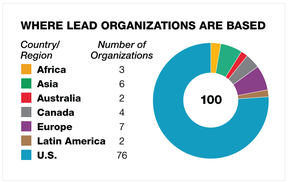The question we get most often is: what makes for a good proposal?
We recently unveiled the highest-scoring proposals in our 100&Change competition, a.k.a. the Top 100. They represent the top 21 percent of competition submissions after being rigorously vetted, through initial administrative review, a Peer-to-Peer review, an evaluation by an external panel of judges, and a technical review by specialists whose expertise was matched to the project.
Each is featured in the Bold Solutions Network, a searchable online collection of the highest-rated submissions that are showcased this way to help applicants gain visibility and funding from a wide array of funders. Collectively, the Top 100 provide $10 billion worth of compelling projects to address some of the world’s most critical social challenges.
With a little reverse engineering, they also offer organizations seeking funding clues about approaches that work. One way of understanding what makes for a successful grant application is to look at how the Top 100 cluster into different groups and classifications. For example, the following groups are heavily represented in the Top 100:
- Previously applied: Nearly half of the Top 100 applied for funding in the inaugural round of 100&Change.
- Large nonprofits and universities: Organizations with more than 1,000 employees or revenues of $1 billion or more accounted for roughly one-third of the Top 100; this included many projects based at universities.
- Responsive to broadly shared concerns: Though it is a harder point to quantify, many high-scoring proposals were part of a group of similarly themed efforts, such as water systems or vision care. Climate, broadly defined, accounts for nearly 20 percent of the Top 100.
We also found groupings by topic, location, and organizational type or project structure.
The leading topic is health, with 39 of the Top 100 proposals addressing health issues, and treatments of specific diseases representing the largest share of health projects, followed by access to care, vision care, mental health and substance abuse, and women’s health.

The majority of lead organizations—76 out of 100—are based in the U.S. Most of the proposed work is focused on the continent of Africa (59 out of 100 projects), or Asia (47); 26 projects are focused on work in the U.S. Most of projects headquartered in the U.S. and proposing work in Africa or Asia have partners based there to help to carry out work on the ground (many work globally or on more than one continent).
Fifty-five of the Top 100 involve collaborations, which are especially common for projects involving universities. For projects with university involvement, we found four types of partnerships typical: university-led with an NGO partner (44 percent); university-led with NGO or other academic partners (27 percent); university-led with only university partners (10 percent); and NGO-led with a university partner (19 percent).